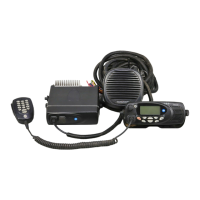TM8100/TM8200 Service Manual Circuit Descriptions 85
© Tait Electronics Limited November 2007
3.6 Power Supply Circuitry
Introduction For a block diagram of the power supply circuitry, refer to Figure 3.9.
The power-supply circuitry consists of the following main sections:
■ supply protection
■ supervisory circuit
■ internal power supplies
■ control of internal power supplies
■ control of external power supply.
Supply Protection Electrical protection to the radio is provided by the clamping diode D600
and by 20A fuses (for >25W radios) and 10A fuses (for 25W radios) in the
positive and negative leads of the power cable. This provides protection from
reverse voltages, positive transients greater than 30V, and all negative
transients. An ADC monitors the supply and is responsible for the protection
of internal devices, which have an operating voltage of less than 30V.
The ADC also ensures protection if the radio operates outside its specified
voltage range of 10.8V to 16V.
Supervisory Circuit The supervisory circuit comprises a reset and watchdog timer. The circuit
provides the reset signal
PSU SYS RST to the digital section, which in turn
provides the watchdog signal
DIG WD KICK required by the supervisory circuit.
Internal Power
Supplies
There are eight internal power supplies:
■ one SMPS (+3V3)
■ four linear regulators (+9V0, +6V0, +3V0 AN, +2V5 CDC)
■ three switched supplies (+9V0 TX, +3V0 RX, +13V8 SW).
The SMPS is used to regulate to 3.3V from the external supply +13
V8 BATT.
The four lower voltages required are then further stepped down with linear
regulators. These all take advantage of the efficiency gain of the SMPS.
The 9V regulator and the 13.8V switched supply are connected to +13
V8
BATT. The two remaining switched supplies (9V and 3V) use P-channel
MOSFETs.
Control of Internal
Power Supplies
The radio can be switched on using the ON/OFF key on the control head or
by means of external signals. For the latter case hardware links are required
and there are several power-sense options; these are discussed below. Some
internal power supplies can be controlled by means of digital lines
depending on the mode in which the radio is operating.
Power-Sense
Options
The radio allows the configuration of different power-sense options to
control how the radio is powered up and down:
■ battery power sense
■ auxiliary power sense (ignition sense)
■ internal-options power sense
■ no power sense
■ emergency power sense.
25W>25W

